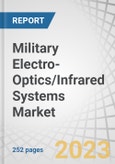The military EO/IR system market size is projected to grow from USD 7.8 billion in 2023 to USD 9.5 billion by 2028, at a CAGR of 4.0% during the forecast period.
As security threats evolve, military forces may need to rely more heavily on EO/IR systems to identify and track potential threats. For example, unmanned aerial vehicles (UAVs) have become a growing concern for military forces, and military EO/IR systems can be used to detect and track these threats.
Land Segment: The second largest share of the military EO/IR system market by platform in 2023.
The Land segment has the second largest segment of the military EO/IR system market by payload in 2023. As technology continues to advance, EO/IR systems have become more powerful, compact, and affordable. This has made them increasingly attractive to military forces, who can use them for a range of applications, from surveillance and reconnaissance to targeting and threat detection.
Cooled technology Segment: The largest segment of the military EO/IR system market by type in 2023
The Cooled technology segment has the largest segment of the military EO/IR system market by type in 2023. Military forces may have specific operational needs that require the use of EO/IR systems. For example, they may need to monitor a particular area for an extended period of time, or they may need to conduct reconnaissance in a remote or dangerous location.
North America to account for the second largest CAGR in the military EO/IR system market in forecasted year
North America is estimated to account for the second largest CAGR in the military EO/IR system market in the forecasted year. The North America region for this study comprises of US, Canada, countries. Rising developments of military EO/IR system by several US based companies.
Break-up of profiles of primary participants in the military EO/IR system market:
- By Company Type: Tier 1 - 35%, Tier 2 - 45%, and Tier 3 - 20%
- By Designation: C-Level Executives - 35%, Directors - 25%, and Others - 40%
- By Region: North America - 25%, Europe - 15%, Asia Pacific - 45%, Rest of the world - 5%, Middle East & Africa - 10%
Prominent companies in the military EO/IR system market are Northrop Grumman Corporation(US), Raytheon Technologies Corporation(US), L3Harris Technologies Inc.(US), Lockheed Martin Corporation (US), Thales Group (France), Aselsan AS (Turkey), Teledyne FLIR (US), BAE System (UK), among others.
Research Coverage:
- The market study covers the military EO/IR system market across segments.
- It aims at estimating the market size and the growth potential of this market across different segments, such Cooling Technology, Imaging Technology, Sensor Technology, Product Type, Platform, Component, Point of Sale and region.
- The study also includes an in-depth competitive analysis of the key players in the market, along with their company profiles, key observations related to product and business offerings, recent developments, and key market strategies.
Key benefits of buying this report:
- This report will help the market leaders/new entrants in this market with information on the closest approximations of the revenue numbers for the overall military EO/IR system market and its subsegments.
- The report covers the entire ecosystem of the military EO/IR system industry and will help stakeholders understand the competitive landscape and gain more insights to better position their businesses and plan suitable go-to-market strategies.
- The report will also help stakeholders understand the pulse of the market and provide them with information on key market drivers, restraints, challenges, and opportunities.
The report provides insights on the following pointers:
- Analysis of key drivers and there are several factors that could contribute to an increase in military electro-optical/infrared (EO/IR) system market.
- Product Development/Innovation: Detailed insights on upcoming technologies, research & development activities, and new product & service launches in the military electro-optical/infrared (EO/IR) system market
- Market Development: Comprehensive information about lucrative markets - the report analyses the military electro-optical/infrared (EO/IR) system market across varied regions
- Market Diversification: Exhaustive information about new products & services, untapped geographies, recent developments, and investments in the military electro-optical/infrared (EO/IR) system market
- Competitive Assessment: In-depth assessment of market shares, growth strategies and service offerings of leading players like Northrop Grumman Corporation(US), Raytheon Technologies Corporation(US), L3Harris Technologies Inc.(US), Lockheed Martin Corporation (US), Thales Group (France), Aselsan AS (Turkey), Teledyne FLIR (US), BAE System (UK), among others in the military electro-optical/infrared (EO/IR) system market
Table of Contents
Companies Mentioned
- Alpha Design Technologies
- Ascendent Technologies
- Ascent Vision Technology Group
- Aselsan A.S.
- Bae Systems
- Elbit Systems
- General Dyanmics Corporation
- Harris Aerial
- Height Technologies
- Hensoldt Ag
- Infiniti Electro Optics
- Israel Aerospace Industries
- Kongsberg
- L3 Harris Technologies Inc.
- Leonardo
- Lockheed Martin Corporation
- Lynred
- Northrop Grumman Corporation
- Rafael Advanced Defense Systems
- Raytheon Technology Corporation
- Rheinmetall Ag
- Teledyne Flir
- Thales Group
- Thales Group
- Vectornav
Methodology

LOADING...
Table Information
| Report Attribute | Details |
|---|---|
| No. of Pages | 252 |
| Published | April 2023 |
| Forecast Period | 2023 - 2028 |
| Estimated Market Value ( USD | $ 7.8 Billion |
| Forecasted Market Value ( USD | $ 9.5 Billion |
| Compound Annual Growth Rate | 4.0% |
| Regions Covered | Global |
| No. of Companies Mentioned | 25 |









